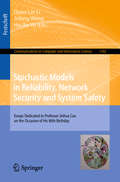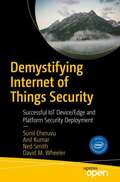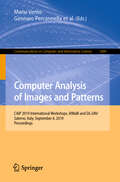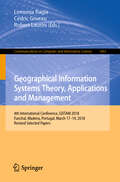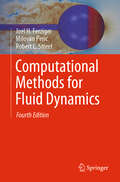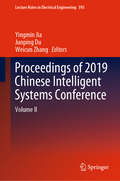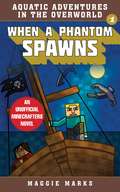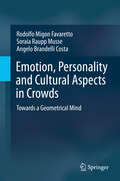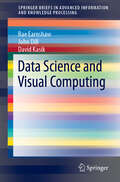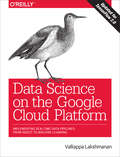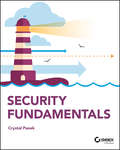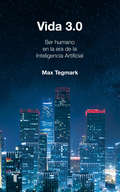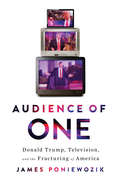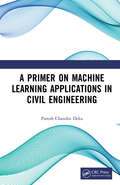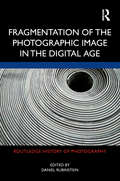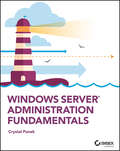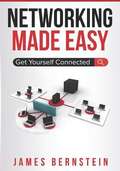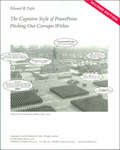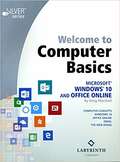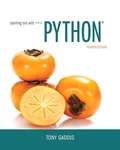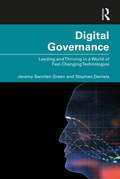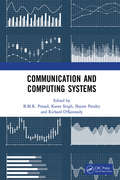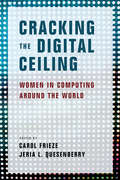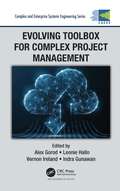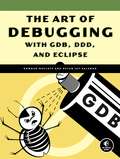- Table View
- List View
Stochastic Models in Reliability, Network Security and System Safety: Essays Dedicated to Professor Jinhua Cao on the Occasion of His 80th Birthday (Communications in Computer and Information Science #1102)
by Quan-Lin Li Jinting Wang Hai-Bo YuThis book is dedicated to Jinhua Cao on the occasion of his 80th birthday. Jinhua Cao is one of the most famous reliability theorists. His main contributions include: published over 100 influential scientific papers; published an interesting reliability book in Chinese in 1986, which has greatly influenced the reliability of education, academic research and engineering applications in China; initiated and organized Reliability Professional Society of China (the first part of Operations Research Society of China) since 1981. The high admiration that Professor Cao enjoys in the reliability community all over the world was witnessed by the enthusiastic response of each contributor in this book. The contributors are leading researchers with diverse research perspectives. The research areas of the book iclude a broad range of topics related to reliability models, queueing theory, manufacturing systems, supply chain finance, risk management, Markov decision processes, blockchain and so forth.The book consists of a brief Preface describing the main achievements of Professor Cao; followed by congratulations from Professors Way Kuo and Wei Wayne Li, and by Operations Research Society of China, and Reliability Professional Society of China; and further followed by 25 articles roughly grouped together. Most of the articles are written in a style understandable to a wide audience. This book is useful to anyone interested in recent developments in reliability, network security, system safety, and their stochastic modeling and analysis.
Demystifying Internet of Things Security: Successful IoT Device/Edge and Platform Security Deployment
by Anil Kumar Sunil Cheruvu Ned Smith David M. WheelerBreak down the misconceptions of the Internet of Things by examining the different security building blocks available in Intel Architecture (IA) based IoT platforms. This open access book reviews the threat pyramid, secure boot, chain of trust, and the SW stack leading up to defense-in-depth.The IoT presents unique challenges in implementing security and Intel has both CPU and Isolated Security Engine capabilities to simplify it. This book explores the challenges to secure these devices to make them immune to different threats originating from within and outside the network. The requirements and robustness rules to protect the assets vary greatly and there is no single blanket solution approach to implement security.Demystifying Internet of Things Security provides clarity to industry professionals and provides and overview of different security solutionsWhat You'll LearnSecure devices, immunizing them against different threats originating from inside and outside the networkGather an overview of the different security building blocks available in Intel Architecture (IA) based IoT platformsUnderstand the threat pyramid, secure boot, chain of trust, and the software stack leading up to defense-in-depthWho This Book Is ForStrategists, developers, architects, and managers in the embedded and Internet of Things (IoT) space trying to understand and implement the security in the IoT devices/platforms.
Computer Analysis of Images and Patterns: CAIP 2019 International Workshops, ViMaBi and DL-UAV, Salerno, Italy, September 6, 2019, Proceedings (Communications in Computer and Information Science #1089)
by Mario Vento Gennaro Percannella Sara Colantonio Daniela Giorgi Bogdan J. Matuszewski Hamideh Kerdegari Manzoor RazaakThis book constitutes the refereed proceedings of two workshops held at the 18th International Conference on Computer Analysis of Images and Patterns, CAIP 2019, held in Salerno, Italy, in September 2019: First Workshop on Deep-learning based Computer Vision for UAV, DL-UAV 2019, and the First Workshop on Visual Computing and Machine Learning for Biomedical Applications, ViMaBi 2019. The 12 papers presented in this volume were carefully reviewed and selected from 16 submissions and focus on all aspects of visual computing and machine learning for biomedical applications, and deep-learning based computer vision for UAV.
Geographical Information Systems Theory, Applications and Management: 4th International Conference, GISTAM 2018, Funchal, Madeira, Portugal, March 17–19, 2018, Revised Selected Papers (Communications in Computer and Information Science #1061)
by Cédric Grueau Robert Laurini Lemonia RagiaThis book constitutes the thoroughly refereed proceedings of the 4th International Conference on Geographical Information Systems Theory, Applications and Management, GISTAM 2018, held in Funchal, Madeira, Portugal, in March 2018.The 7 revised full papers presented were carefully reviewed and selected from 58 submissions. The papers are centered on urban and regional planning; water information systems; geospatial information and technologies; spatio-temporal database management; decision support systems; energy information systems; GPS and location detection.
Computational Methods for Fluid Dynamics
by Joel H. Ferziger Milovan Perić Robert L. StreetThis book is a guide to numerical methods for solving fluid dynamics problems. The most widely used discretization and solution methods, which are also found in most commercial CFD-programs, are described in detail. Some advanced topics, like moving grids, simulation of turbulence, computation of free-surface flows, multigrid methods and parallel computing, are also covered. Since CFD is a very broad field, we provide fundamental methods and ideas, with some illustrative examples, upon which more advanced techniques are built. Numerical accuracy and estimation of errors are important aspects and are discussed in many examples. Computer codes that include many of the methods described in the book can be obtained online. This 4th edition includes major revision of all chapters; some new methods are described and references to more recent publications with new approaches are included. Former Chapter 7 on solution of the Navier-Stokes equations has been split into two Chapters to allow for a more detailed description of several variants of the Fractional Step Method and a comparison with SIMPLE-like approaches. In Chapters 7 to 13, most examples have been replaced or recomputed, and hints regarding practical applications are made. Several new sections have been added, to cover, e.g., immersed-boundary methods, overset grids methods, fluid-structure interaction and conjugate heat transfer.
Proceedings of 2019 Chinese Intelligent Systems Conference: Volume II (Lecture Notes in Electrical Engineering #593)
by Yingmin Jia Junping Du Weicun ZhangThis book showcases new theoretical findings and techniques in the field of intelligent systems and control. It presents in-depth studies on a number of major topics, including: Multi-Agent Systems, Complex Networks, Intelligent Robots, Complex System Theory and Swarm Behavior, Event-Triggered Control and Data-Driven Control, Robust and Adaptive Control, Big Data and Brain Science, Process Control, Intelligent Sensor and Detection Technology, Deep learning and Learning Control, Guidance, Navigation and Control of Aerial Vehicles, and so on. Given its scope, the book will benefit all researchers, engineers, and graduate students who want to learn about cutting-edge advances in intelligent systems, intelligent control, and artificial intelligence.
When a Phantom Spawns: An Unofficial Minecrafters Novel (Aquatic Adventures in the Overworld #1)
by Maggie MarksA brand-new series about the underwater world of Minecraft! Brothers Mason and Asher have only ever known the comfort of dry land in the Overworld. But when a terrifying shipwreck leaves them stranded, their new friend Luna urges them to safe haven—underwater. In each story of the all-new series for Minecrafters, Aquatic Adventures in the Overworld, this unlikely trio must make the choice of staying in the world they know best and risk death, or voyaging into an unknown world where anything could happen. Follow their journey as Mason, Asher, and Luna face incredible obstacles and discover strength they never knew they had in Aquatic Adventures in the Overworld. In their first aquatic adventure, Mason and his brother, Asher, wake to find themselves shipwrecked on a deserted beach. Where are they? How’d they get here? And how will they survive? They’ve lost their map, and now Mason is losing sleep, too. Are those phantoms swirling overhead, waiting to strike? A new friend, Luna, urges the brothers to follow her underwater to the safety of the ocean floor—before it’s too late. . .
Emotion, Personality and Cultural Aspects in Crowds: Towards a Geometrical Mind
by Rodolfo Migon Favaretto Soraia Raupp Musse Angelo Brandelli CostaThis practically-focused book presents a computational model for detection and analysis of pedestrian features in crowds from video sequences.The study of human behavior is a subject of great scientific interest and probably an inexhaustible source of research. The analysis of pedestrians and groups in crowds is relevant in several areas of application, such as security, entertainment, environmental and public spaces planning and social sciences. Cultural and personality aspects are attributes that can influence personal behavior and affect the group in which individuals belong.In this sense, we consider different ways of characterizing individuals and groups in crowds with respect to their relationship with the geometrical space and time. We discuss and describe an approach to extract and analyse, from the Computer Science point of view, emotions, personalities and cultural aspects from crowds and groups of pedestrians, using Computer Vision techniques.Extracting characteristics from real pedestrians and crowds, benefits other areas, such as: architecture and design (planning spaces to maximize pedestrian and group-environment fit); security and surveillance (design of evacuation plans considering characteristics of the crowds and detection of abnormal events); entertainment (more realistic crowds in movies and games reproducing characteristics from real pedestrians and crowds); social sciences (understanding of human behavior), among others.A big challenge in this area of research is the comparison with real life data. In this book, we successfully compared the results of the proposed approach with Psychology literature, where several studies aimed to analysis human behavior.
Data Science and Visual Computing (Advanced Information and Knowledge Processing)
by Rae Earnshaw David Kasik John DillData science addresses the need to extract knowledge and information from data volumes, often from real-time sources in a wide variety of disciplines such as astronomy, bioinformatics, engineering, science, medicine, social science, business, and the humanities. The range and volume of data sources has increased enormously over time, particularly those generating real-time data. This has posed additional challenges for data management and data analysis of the data and effective representation and display. A wide range of application areas are able to benefit from the latest visual tools and facilities. Rapid analysis is needed in areas where immediate decisions need to be made. Such areas include weather forecasting, the stock exchange, and security threats. In areas where the volume of data being produced far exceeds the current capacity to analyze all of it, attention is being focussed how best to address these challenges. Optimum ways of addressing large data sets across a variety of disciplines have led to the formation of national and institutional Data Science Institutes and Centers. Being driven by national priority, they are able to attract support for research and development within their organizations and institutions to bring together interdisciplinary expertise to address a wide variety of problems. Visual computing is a set of tools and methodologies that utilize 2D and 3D images to extract information from data. Such methods include data analysis, simulation, and interactive exploration. These are analyzed and discussed.
Data Science on the Google Cloud Platform: Implementing End-to-End Real-Time Data Pipelines: From Ingest to Machine Learning
by Valliappa LakshmananLearn how easy it is to apply sophisticated statistical and machine learning methods to real-world problems when you build on top of the Google Cloud Platform (GCP). This hands-on guide shows developers entering the data science field how to implement an end-to-end data pipeline, using statistical and machine learning methods and tools on GCP. Through the course of the book, you’ll work through a sample business decision by employing a variety of data science approaches.Follow along by implementing these statistical and machine learning solutions in your own project on GCP, and discover how this platform provides a transformative and more collaborative way of doing data science.You’ll learn how to:Automate and schedule data ingest, using an App Engine applicationCreate and populate a dashboard in Google Data StudioBuild a real-time analysis pipeline to carry out streaming analyticsConduct interactive data exploration with Google BigQueryCreate a Bayesian model on a Cloud Dataproc clusterBuild a logistic regression machine-learning model with SparkCompute time-aggregate features with a Cloud Dataflow pipelineCreate a high-performing prediction model with TensorFlowUse your deployed model as a microservice you can access from both batch and real-time pipelines
Security Fundamentals
by Crystal PanekA Sybex guide to Windows Security concepts, perfect for IT beginners Security is one of the most important components to every company’s computer network. That’s why the Security Fundamentals MTA Certification is so highly sought after. Filling IT positions is a top problem in today’s businesses, so this certification could be your first step toward a stable and lucrative IT career. Security Fundamentals is your guide to developing a strong foundational understanding of Windows security, so you can take your IT career to the next level and feel confident going into the certification exam. Security Fundamentals features approachable discussion of core security concepts and topics, and includes additional learning tutorials and tools. This book covers everything you need to know about security layers, authentication, authorization, security policies, and protecting your server and client. Each chapter closes with a quiz so you can test your knowledge before moving to the next section. Learn everything you need for the Security Fundamentals MTA Certification Understand core security principles, including security layers and network security Learn essential concepts in physical security, internet security, and wireless security Identify the different types of hardware firewalls and their characteristics Test your knowledge and practice for the exam with quiz questions in every chapter IT professionals looking to understand more about networking will gain the knowledge to effectively secure a client and server, and to confidently explain basic security concepts. Thanks to the tools and tips in this Sybex title, you will be able to apply your new IT security skills in real world situations and on exam day.
Vida 3.0
by Max Tegmark¿Cómo afectará la inteligencia artificial al crimen, a la guerra, a la justicia, al trabajo, a la sociedad y al sentido de nuestras vidas? Bienvenidos a la conversación más importante de nuestro tiempo. ¿Cómo afectará la inteligencia artificial al crimen, a la guerra, a la justicia, al trabajo, a la sociedad y al sentido de nuestras vidas? ¿Es posible que las máquinas nos dejen fuera de juego, remplazando a los humanos en el mercado laboral e incluso en otros ámbitos? ¿La inteligencia artificial proveerá mejoras sin precedente a nuestras vidas o nos dará más poder del que podemos manejar? Muchas de las cuestiones más fundamentales de la actualidad están íntimamente relacionadas con el aumento de la inteligencia artificial. Max Tegmark no se asusta ante la gama completa de puntos de vista o ante los temas más controvertidos, desde la superinteligencia hasta el significado, la conciencia y los límites físicos últimos de la vida en el cosmos. En Vida 3.0, clarifica los conceptos clave necesarios para hablar de inteligencia artificial al tiempo que ayuda a entender la importancia de las cuestiones clave, aquellas que la humanidad tendrá que abordar en las próximas décadas. Reseñas:«Todos nosotros, no solo científicos, industriales y generales, deberíamos preguntarnos qué puede hacerse ahora para aumentar las posibilidades de cosechar los beneficios de la IA futura y evitar sus riesgos. Esta es la conversación más importante de nuestro tiempo, y con este estimulante libro Tegmark te ayudará a participar en ella.»Stephen Hawking «Enriquecedor y visionario. Todo el mundo debería leerlo.»The Times «Tegmark explica con brillantez numerosos conceptos del terreno de la informática al de la cosmología, escribe con modestia y sutileza intelectual, le ofrece al lector el importante servicio de definir sus términos con claridad, y con razón rinde homenaje a las mentes creativas de los escritores de ciencia ficción que, por supuesto, abordaron este tipo de preguntas hace más de medio siglo.»Steven Poole, The Telegraph «Original, accesible y provocador. Tegmark ilumina las numerosas facetas de la inteligencia artificial. Disfruten del viaje y saldrán del otro extremo con una mejor apreciación de adónde podría llevarnos la tecnología en los próximos años.»Science «Una guía convincente por los retos y dilemas en nuestra búsqueda de un gran futuro de la vida, la inteligencia y la consciencia, en la Tierra y más allá de esta.»Elon Musk Estimulante. La discusión inteligente y desenfrenada de Tegmark conduce a fascinantes especulaciones sobre civilizaciones basadas en la inteligencia artificial que abarcan galaxias y eones. Absorbente.»Publishers Weekly
Audience of One: Donald Trump, Television And The Fracturing Of America
by James PoniewozikOne of the Top 10 Politics and Current Events Books of Fall 2019 (Publishers Weekly) An incisive cultural history that captures a fractious nation through the prism of television and the rattled mind of a celebrity president. Television has entertained America, television has ensorcelled America, and with the election of Donald J. Trump, television has conquered America. In Audience of One, New York Times chief television critic James Poniewozik traces the history of TV and mass media from the Reagan era to today, explaining how a volcanic, camera-hogging antihero merged with America’s most powerful medium to become our forty-fifth president. In the tradition of Neil Postman’s masterpiece Amusing Ourselves to Death, Audience of One shows how American media have shaped American society and politics, by interweaving two crucial stories. The first story follows the evolution of television from the three-network era of the 20th century, which joined millions of Americans in a shared monoculture, into today’s zillion-channel, Internet-atomized universe, which sliced and diced them into fractious, alienated subcultures. The second story is a cultural critique of Donald Trump, the chameleonic celebrity who courted fame, achieved a mind-meld with the media beast, and rode it to ultimate power. Braiding together these disparate threads, Poniewozik combines a cultural history of modern America with a revelatory portrait of the most public American who has ever lived. Reaching back to the 1940s, when Trump and commercial television were born, Poniewozik illustrates how Donald became “a character that wrote itself, a brand mascot that jumped off the cereal box and entered the world, a simulacrum that replaced the thing it represented.” Viscerally attuned to the media, Trump shape-shifted into a boastful tabloid playboy in the 1980s; a self-parodic sitcom fixture in the 1990s; a reality-TV “You’re Fired” machine in the 2000s; and finally, the biggest role of his career, a Fox News–obsessed, Twitter-mad, culture-warring demagogue in the White House. Poniewozik deconstructs the chaotic Age of Trump as the 24-hour TV production that it is, decoding an era when politics has become pop culture, and vice versa. Trenchant and often slyly hilarious, Audience of One is a penetrating and sobering review of the raucous, raging, farcical reality show—performed for the benefit of an insomniac, cable-news-junkie “audience of one”—that we all came to live in, whether we liked it or not.
A Primer on Machine Learning Applications in Civil Engineering
by Paresh Chandra DekaMachine learning has undergone rapid growth in diversification and practicality, and the repertoire of techniques has evolved and expanded. The aim of this book is to provide a broad overview of the available machine-learning techniques that can be utilized for solving civil engineering problems. The fundamentals of both theoretical and practical aspects are discussed in the domains of water resources/hydrological modeling, geotechnical engineering, construction engineering and management, and coastal/marine engineering. Complex civil engineering problems such as drought forecasting, river flow forecasting, modeling evaporation, estimation of dew point temperature, modeling compressive strength of concrete, ground water level forecasting, and significant wave height forecasting are also included. Features Exclusive information on machine learning and data analytics applications with respect to civil engineering Includes many machine learning techniques in numerous civil engineering disciplines Provides ideas on how and where to apply machine learning techniques for problem solving Covers water resources and hydrological modeling, geotechnical engineering, construction engineering and management, coastal and marine engineering, and geographical information systems Includes MATLAB® exercises
Fragmentation of the Photographic Image in the Digital Age (Routledge History of Photography)
by Daniel RubinsteinFragmentation of the Photographic Image in the Digital Age challenges orthodoxies of photographic theory and practice. Beyond understanding the image as a static representation of reality, it shows photography as a linchpin of dynamic developments in augmented intelligence, neuroscience, critical theory, and cybernetic cultures. Through essays by leading philosophers, political theorists, software artists, media researchers, curators, and experimental programmers, photography emerges not as a mimetic or a recording device but simultaneously as a new type of critical discipline and a new art form that stands at the crossroads of visual art, contemporary philosophy, and digital technologies.
Windows Server Administration Fundamentals
by Crystal PanekDid you know, 91% of hiring managers consider certification as part of their hiring requirements? IT Professionals who are new to the industry need a strong foundational understanding of the fundamentals before moving on towards more challenging technology certifications. This book covers everything you need to know about understanding how to manage windows servers and storage along with monitoring and troubleshooting servers as well. Written to the Windows Server Administration Fundamentals MTA Certification, it is a recommended entry point into IT certification. This book covers the basics of Windows Server Administration. Each chapter closes with a quiz to make sure you can practice exam questions and test your knowledge begore moving to the next section. We start by discussing what a server is and does by providing an in-depth overview including installation of Windows Server 2016. There are sections dedicated to the following: Preforming configurations and managing your Windows Server, by configuring your IP address settings and managing devices and device drivers. Managing your storage, by identifying storage technologies, understanding disk structure, and using disk management tools. Monitoring and troubleshooting servers, by managing information technology, and understanding performance, backups and preforming server repair. Overview of popular Windows network services and applications, like understanding remote access, server virtualization, and introducing remote administration. IT Professionals looking to understand more about Windows Server Administration will gain he knowledge to effectively install and manage a Windows Server including basic troubleshooting. Thanks to some troubleshooting tools and tops it will be easier to apply the skills in real world situations and feel confident when taking the certification.
Networking Made Easy: Get Yourself Connected (Computers Made Easy)
by James BernsteinNetworking Made Easy is designed to take your overall networking skills from a beginner to the next level. Get a top-level understanding without a complex education. This easy to use guide will help you navigate your way to becoming proficient with network fundamentals and technology.
The Cognitive Style Of PowerPoint: Pitching Out Corrupts Within
by Edward TufteIn corporate and government bureaucracies, the standard method for making a presentation is to talk about a list of points organized onto slides projected up on the wall. For many years, overhead projectors lit up transparencies, and slide projectors showed high-resolution 35mm slides. Now 'slideware' computer programs for presentations are nearly everywhere. Early in the 21st century, several hundred million copies of Microsoft PowerPoint were turning out trillions of slides each year. Unfortunately, slideware often reduces the analytical quality of presentations. In particular, the popular PowerPoint templates (ready-made designs) usually weaken verbal and spatial reasoning, and almost always corrupt statistical analysis. The author examines how these problems can be avoided and how to improve Powerpoint (and other) presentations.
Welcome to Computer Basics: Microsoft Windows 10 and Office Online
by Greg MarshallWelcome to Computer Basics is a complete introduction to Microsoft's newest operating system Windows 10 and all its exciting new features.
Starting Out With Python
by Tony GaddisIn Starting Out with Python®, 4th Edition, Tony Gaddis’ accessible coverage introduces students to the basics of programming in a high level language. Python, an easy-to-learn and increasingly popular object-oriented language, allows readers to become comfortable with the fundamentals of programming without the troublesome syntax that can be challenging for novices. With the knowledge acquired using Python, students gain confidence in their skills and learn to recognize the logic behind developing high-quality programs. Starting Out with Python discusses control structures, functions, arrays, and pointers before objects and classes. As with all Gaddis texts, clear and easy-to-read code listings, concise and practical real-world examples, focused explanations, and an abundance of exercises appear in every chapter. Updates to the 4th Edition include revised, improved problems throughout, and new Turtle Graphics sections that provide flexibility as assignable, optional material.
Digital Governance: Leading and Thriving in a World of Fast-Changing Technologies
by Stephen Daniels Jeremy Swinfen GreenDigital Governance provides managers with a simple and jargon-free introduction to the impact that digital technology can have on the governance of their organisations. Digital technology is at the heart of any enterprise today, changing business processes and the way we work. But this technology is often used inefficiently, riskily or inappropriately. Worse perhaps, many organisational leaders fail to grasp the opportunities it offers and thus fail to "transform" their organisations through the use of technology. This book provides an explanation of the basic issues around the opportunities and risks associated with digital technology. It describes the role that digital technology can play across organisations (and not just behind the locked doors of the IT department), giving boards and top management the insight to develop strategies for investing in and exploiting digital technology as well as arming them with the knowledge required to ask the right questions of specialists and to detect when the answers given are evasive or irrelevant. International in its scope, this essential book covers the fundamental principles of digital governance such as leadership, capability, accountability for value creation and transparency of reporting, integrity and ethical behaviour.
Communication and Computing Systems: Proceedings of the 2nd International Conference on Communication and Computing Systems (ICCCS 2018), December 1-2, 2018, Gurgaon, India
by Karan Singh Richard O'Kennedy B. M. K. Prasad Shyam S. PandeyThe International Conference on Communication and Computing Systems (ICCCS 2018) provides a high-level international forum for researchers and recent advances in the field of electronic devices, computing, big data analytics, cyber security, quantum computing, biocomputing, telecommunication, etc. The aim of the conference was to bridge the gap between the technological advancements in the industry and the academic research.
Cracking the Digital Ceiling: Women in Computing around the World
by Carol Frieze Jeria L. QuesenberryIs computing just for men? Are men and women suited to different careers? This collection of global perspectives challenges these commonly held western views, perpetuated as explanations for women's low participation in computing. By providing an insider look at how different cultures worldwide impact the experiences of women in computing, the book introduces readers to theories and evidence that support the need to turn to environmental factors, rather than innate potential, to understand what determines women's participation in this growing field. This wakeup call to examine the obstacles and catalysts within various cultures and environments will help those interested in improving the situation understand where they might look to make changes that could impact women's participation in their classrooms, companies, and administrations. Computer scientists, STEM educators, students of all disciplines, professionals in the tech industry, leaders in gender equity, anthropologists, and policy makers will all benefit from reading this book.
Evolving Toolbox for Complex Project Management (Complex and Enterprise Systems Engineering)
by Indra Gunawan Alex Gorod Vernon Ireland Leonie HalloThis book enhances learning about complex project management principles and practices through the introduction and discussion of a portfolio of tools presented as an evolving toolbox. Throughout the book, industry practitioners examine the toolsets that are part of the toolbox to develop a broader understanding of complex project management challenges and the available tools to address them. This approach establishes a dynamic, structured platform for a comprehensive analysis and assessment of the modern, rapidly changing, multifaceted business environment to teach the next generation of project managers to successfully cope with the ever increasing complexity of the 21st century.
The Art of Debugging with GDB, DDD, and Eclipse: For Professionals And Students
by Norman Matloff Peter Jay SalzmanDebugging is crucial to successful software development, but even many experienced programmers find it challenging. Sophisticated debugging tools are available, yet it may be difficult to determine which features are useful in which situations. The Art of Debugging is your guide to making the debugging process more efficient and effective.The Art of Debugging illustrates the use three of the most popular debugging tools on Linux/Unix platforms: GDB, DDD, and Eclipse. The text-command based GDB (the GNU Project Debugger) is included with most distributions. DDD is a popular GUI front end for GDB, while Eclipse provides a complete integrated development environment.In addition to offering specific advice for debugging with each tool, authors Norm Matloff and Pete Salzman cover general strategies for improving the process of finding and fixing coding errors, including how to:–Inspect variables and data structures–Understand segmentation faults and core dumps–Know why your program crashes or throws exceptions–Use features like catchpoints, convenience variables, and artificial arrays–Avoid common debugging pitfallsReal world examples of coding errors help to clarify the authors’ guiding principles, and coverage of complex topics like thread, client-server, GUI, and parallel programming debugging will make you even more proficient. You'll also learn how to prevent errors in the first place with text editors, compilers, error reporting, and static code checkers.Whether you dread the thought of debugging your programs or simply want to improve your current debugging efforts, you'll find a valuable ally in The Art of Debugging.
